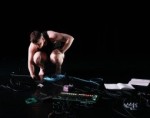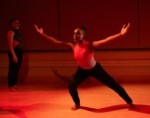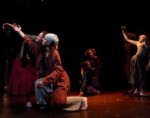
When Something Does Not Exist, We Must Create It
by Rachel DeForrest Repinz
A few weeks back, I was invited to join Embraced Body for their inaugural How We Move dance intensive, a program created for and by Disabled dancers which provides multiply marginalized (BIPOC, LGBTQIA+, etc.) dancers opportunities for virtual and in-person learning, supported by the Mellon Foundation. The six-month hybrid program combines virtual gatherings with a 10-day in-person intensive at Movement Research in New York City. I was lucky enough to join facilitators Kayla Hamilton, India Harville, and JJ Omelagah, along with six participating artists, for a variety of workshops, ‘hot topic’ discussions, and a culminating sharing.
As I walk into the studio for my first visit on Juneteenth, access is at the forefront. Daily COVID pre-testing is required, everyone is masked, live CART captioning is projected onto TV screens in the studio, and the day begins with a group access check-in in one of Movement Research’s newly built-out studios at the 122 Community Center in the East Village. After checking in, dancers jump straight into movement with Kayla Hamilton offering a Guinean-based warm-up, abundant with modifications and differentiated embodied approaches as entry points to the African diasporic form. Dancers participate while standing, seated, and fluidly transitioning between movement approaches. Even as an observer, I’m swept up in the energy, so much so that I find myself moving along from my seat.
Following the morning warm-up, the day unfolds through a series of 'hot topic' discussions exploring various facets of disability and community building, and movement workshops led by the facilitating team and participating artists. During my second visit, I observe a workshop led by Zen Spencer, a multidisciplinary artist currently studying Dance and Visual Art at Bennington College. Zen’s workshop, “Galaxies Within: A Workshop on Breath, Energy, and Expression” brings together Afro-futurism, Alexander Technique, breathwork, and musical scores by The Sun Ra Arkestra. As we explore our inner galaxies through movement and visual artmaking, dancers flow in and out of the space, tending to their own access needs, and offering the occasional “yas!” and “you got this!” as Zen and her mother, Aiesha, guide us through their offering.
My final visit with the group is as an audience member at their public culminating sharing, Studies Project: How We Move – Access Wisdom and Artistry. The effects of the How We Move team’s commitment to community building are palpable as I enter the 122 Community Center, immediately greeted by friends and colleagues from across the disability-dance community. As we sit in a circle with the How We Move team and artists, India Harville welcomes us: “This is a little show n’ tell.” The program weaves together audience questions, artist-driven dialogues, and a collective movement offering of Hector Machado's Accessible Majorette Dance technique. Hector introduces the movement sharing with a reflection on their work, which has been developed through a Creative Connections research incubator: “When something does not exist, we must create it.” Marching band horns blare as dancers get into formation. Hector leads as the majorette captain, “throwing” intricate arm-based choreography for the others to “catch,” which they describe as “creating spontaneous yet synchronized magic.”
After a brief access pause (a break in programming to address emergent access-related needs), discussions continue to unfold. The audience asks how this inaugural intensive came to be, and how they can bring these practices back to their own communities. “This work takes a lot of time,” Harville says. “It takes time, tenderness, tenacity, $10 million dollars, and a building.” The audience giggles and nods in agreement. Harville speaks not only to the labor and care required to facilitate diverse access needs, but also to the tangible reality of the financial support needed to develop this kind of programming. While Harville suggests that, in many cases, “money becomes an excuse not to provide access,” Hamilton draws attention to the fact that “it can be expensive.” She continues, “I want to highlight the grit [it takes]... the tenderness, but also the EUGH!” She flicks her arms forward and slumps her shoulders, exclaiming, “I’m just being real!”
The attention turns to the artists, offering reflections on the impact of a program like this that honors individualized access and brings together cross-disability communities. Artist Dev Hill reflects on their journey leading up to their participation in the intensive. “I keep meeting me over, and over, and over again,” to which a resounding “mmmhmm!” and affirming snaps burst from the audience. Pointing to the need for more cross-disability dance programming, Assaleh Bibi shares: “Let’s keep going, let’s keep doing it… and you do it too!” The artists press the importance of creating dance spaces that liberate Disabled artists from the ableist gaze that expects them to conform not only to non-Disabled norms, but also to heteronormativity. “Nobody knows how to get liberated,” Harville says, but it’s important that we try together, relentlessly.
How We Move is not only a model for what access-centered dance programming can be–it’s a call to action, reminding us that liberation is a collective, ongoing practice, and that barriers of time, money, and space are only as immovable as we allow them to be. Aiesha reminds us, “imagination goes beyond money.” Access work, at its core, is an act of radical imagination, a reaching toward futures not yet written, shaped by care, creativity, and the belief that another way through is possible.
How We Move Dance Intensive, Embraced Body, Movement Research, March 1-May 7.
Homepage Image Description: JJ Omelagah, holding a mic for Kayla Hamilton, inside of a Movement Research studio. Kayla is demonstrating a movement for the How We Move cohort with both arms pointing in opposing directions. Both folks are masked.
Article Page Image Description: How We Move artists rehearsing majorette dance in the studio. Featured are Hector Machado, Jackie Robinson, and Kayla Hamilton. Everyone is masked with their left arm and index finger pointing outward to the side, and their right hand on their hip. The shot is taken from behind the dancers. In the front, captions are being shared on a large TV screen.
By Rachel DeForrest Repinz
July 9, 2025







